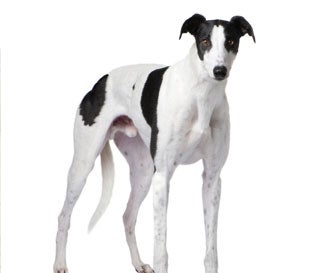Learn about dog breeds
Detailed information & photos on over 190 different breeds
Description
Greyhounds are most known for their racing abilities. This breed can run up to 40 miles per hour. These dogs make a great pet as well as a good hunting dog because of their good eyesight and great sense of smell.
The visual appearance of this dog consists of sleek and slim. Their spines are highly flexible which makes them run at the rate that they can race. Their tail is long with a curl at the end.
You can have a show Greyhound or a racing breed. The racing breed will have more health problems, a different demeanor and different body type compared to the show dog. Both are easily trained to be good pets and the racing breed will become calm when kept as a pet in the home.
Coat Description
The greyhound has fine hair. If you have a greyhound for a pet you will not notice but he will continuously shed throughout the year. During the summer months, he may become bald on some parts of his body. In the winter, he may need a sweater to keep warm in colder climates.
History
The history of the Greyhound is found in hunting. In the middle ages, this dog was brought to England from Arabia. Because of this breed's speed, ability to chase and kill prey made this an excellent and desired dog in England.
In the 16th and 19th century, the breed was considered a part of nobility due to being used to pull carriages. In the 20th century, Greyhounds were considered two breeds, racing and show dogs. The racing dogs were trained much differently than the show dogs. Their temperaments are quite different and they bodies are even built differently which makes them fill the differentiation in the two breeds.
Temperament
This breed is intelligent and can be trained easily. As a pet, this dog is calm and lazy. They are not very interested in people, which make them easy to care for. They do not bark very much because they really don't care what goes on around them. They are not good guard dogs or watch dogs since they just don't seem to react to loud noises or strangers.
If you have another pet in the home, make sure it isn't a small animal like a cat or rabbit because they will chase and prey them. If you have another dog, the Greyhound normally gets along quite well with other breeds of dogs.
Children are not a problem with this dog. They do not enjoy children jumping and bothering them often. They prefer staying by themselves and do not engage in play with children. This breed is not aggressive and just walks away from annoyances.
Health Problems
Show Greyhound dogs are generally healthy. The racing breed has the most health problems because of the extreme stress and physical excursion they undergo. The most common ailment is Hip Dysplasia. This breed can suffer from this at age 4 years or older.
Because of this dog's sleek and slim body they have fragile bones that can break easily. This may happen if running on unlevelled terrains. Make sure to take your dog running on flat land or better yet, a concrete track or lot.
The dog has sensitive skin so it is sensitive to chemicals. Greyhounds can break out in hives after bathing because of the chemicals in the soap. Flea collars are another factor that could cause hives so make sure you check to see if it is causing a problem.
Bloat is common in all dogs. Do not feed your dog a large quantity of food at one time. This causes discomfort and serious illness if too much is ingested.
Grooming
Due to this dog's fine hair and lack of hair it is very easy to maintain this dog. You can brush your Greyhound every one or two weeks. You will need to trim his nails every few weeks unless he goes outside and runs on cement, which will file nails down to an appropriate length.
Ear cleaning is important because of the ears flopping down. The ears can become extremely dirty and develop ear mites. You will notice that he will scratch at his ears when he has this condition. You can use a q-tip and cotton to clean them out.
Exercise
These dogs love physical activity such as chasing and running. Try to take your dog to a park that is enclosed so that he can run freely. You can also either run with your dog or ride a bike while having him on the leash. This is a great way to get your dog to run at the speed it is accustomed.
It is important that you provide your dog with exercise because it prevents him from health problems and keeps him from getting bored. They love to run so allow them to do what they were born to do.
Training
Training Greyhounds is relatively easy because of their intelligence. If you inherit a dog from the races, you will need to train your dog to walk up stairs. You will also find that the crate is a great sanctuary for your Greyhound. You need to choose a good sized crate so that he can move around freely. In the process of training, this dog can be stubborn but being firm and consistent is the best way to get him to understand why he needs to obey. They want to please their master and continue to be loyal to the entire family.
Housebreaking does not seem to be a problem for this breed. The best way to do this is take out your dog frequently especially first thing the morning, after meals and before bed. Your dog will soon catch on that he should use the bathroom outside.
Advertise | Privacy Policy | Terms of Use | Contact Us © Copyright 2004-2024 PupCity.com. All rights reserved.
